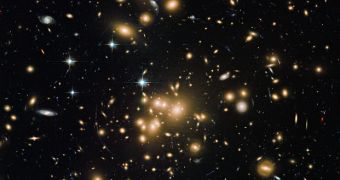A team of astronomers in the United States announces the discovery of a population of very distant and very faint galaxies, which played a role in creating the earliest stars that populated the Universe long ago. These populations have been suspected for a long time, but never before seen in actuality.
The study was conducted by experts with the University of California in Riverside, and detailed in a conference held on January 7 at the 223rd annual meeting of the American Astronomical Society (AAS), in Washington DC. A paper detailing the findings appeared in the January 10 issue of the Astrophysical Journal.
For this investigation, experts used the NASA/ESA Hubble Space Telescope and the ground-based W. M. Keck Observatory, in Hawaii. Study efforts were centered on the early Universe, which was found to be populated by numerous small and faint galaxies. Hubble was able to detect them at ultraviolet wavelengths.
The Keck I Telescoope on Mauna Kea was then used to confirm the discoveries, the team reported at the AAS meeting. A total of 58 such galaxies were detected, all located more than 10 billion light-years away from Earth. The Universe itself is estimated to be around 13.75 billion years old.
In order to analyze this galaxy sample, the Keck I team used the telescope's faint-light Low Resolution Imaging Spectrograph (LRIS) instrument, which can easily detect distant objects such as galaxies, active galactic nuclei, clusters, and active black holes called quasars.
“This was important in determining that our selection of these galaxies was correct,” explained Brian Siana, an assistant professor with the UCR Department of Physics and Astronomy, who was also the leader of the new investigation.
“The LRIS instrument on Keck is ideally suited for obtaining redshifts for these galaxies because it is the most sensitive spectrograph in the world at blue wavelengths, which is where many (if not most) of these galaxies emit most of their light,” he added.
According to the research team, the distant galaxies included in the new dataset existed when the Cosmos was just 3.4 billion years old, and were only discovered because the study used the galaxy cluster Abel 1689 as a gravitational lens.
“There’s always been a concern that we’ve only found the brightest of the distant galaxies. The bright galaxies, however, represent the tip of the iceberg,” Siana says.
“We believe most of the stars forming in the early universe are occurring in galaxies we normally can’t see at all. Now we have found those ‘unseen’ galaxies, and we’re really confident that we’re seeing the rest of the iceberg,” he concludes.

 14 DAY TRIAL //
14 DAY TRIAL //